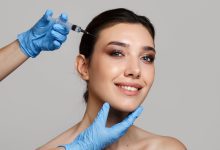These 15 Hydrating Eye Creams Will Plump, Smooth, and Refresh Tired Eyes

In winter, my skin resembles a desert, and I immediately begin applying all the creams, serums, and moisturizers I have in my vanity cabinet. The dryness creeps onto my eyelids, too, and I think it causes my eyes to look tired and my dark circles to look even more pronounced. To make matters worse, the dryness can be irritating, causing the skin on my eyelids to be even more sensitive than normal. What a great time, right?
Since I’ve been dealing with this problem for a couple of years, I have my dryness-fighting routine down. I use gentle makeup removers, cleansers, and exfoliants to avoid stripping my skin of its precious natural oils. I use my thickest moisturizers and cooling serums that sink right into my skin. And I try to be extra minimal with makeup when my skin is going through an exceptionally dry patch. The fewer products I have on my face, the better.
While I have been able to get the rest of my face under control, I’m still figuring out how to deal with the dryness around my eyes. I’ve found some products that work but don’t have it down pat quite yet. So I went to an expert to get her tips on soothing that area.

“The skin around the eye, known as the periocular skin, is unique, fragile, and sensitive,” Robyn Gmyrek, a board-certified dermatologist at Park View Laser Dermatology, explains. “It is the thinnest skin on the face, and it has fewer oil glands, making it more prone to dryness. If we allow this delicate skin to get dried out, this will compromise the skin barrier, leading to an increased risk of inflammation or irritation and even infection. In addition, the periocular skin is usually the first area where we see signs of aging, starting in the third decade of life. If dryness, inflammation, and irritation occur, this will lead to even more extensive and premature skin aging.”
Luckily, there are some things you can do to prevent dryness. Gmyrek says the best thing you can do is focus on strengthening the skin barrier since a damaged barrier won’t be able to hold onto moisture. You can do this by using gentle, non-irritating skincare products, including a hydrating eye cream. Products that irritate the skin are no-gos since irritation can cause microscopic breaks in the skin surface and compromise the skin barrier.

Ingredients to Look For in a Hydrating Eye Cream
When shopping for an eye cream, you want to choose a product that is clearly labeled as such. Gmyrek says you should treat the area sensitively, and knowing that the product is specifically formulated for that delicate area is your best bet. “Though the FDA does not specifically regulate testing to be done in order to label a cream specific for the skin of the eye area, most companies do their own testing on this delicate skin to minimize any risk to the consumer of irritation,” she adds. “I recommend that you always use only a small amount of cream at first to be sure you are not allergic. If any irritation occurs, discontinue use immediately.”
If you are looking for an eye cream for hydrating purposes and not anti-aging reasons, Gmyrek recommends avoiding retinol, which can be drying.
As for ingredients, you’ll want eye creams that include occlusives, humectants, emollients, and/or barrier ingredients. (Gmyrek breaks down what those terms mean below.) She notes that your eye cream doesn’t have to contain all of these ingredients, but most eye creams contain some combination of them.

Occlusives: These form a barrier over the skin surface to prevent the evaporation of water, thereby reducing transepidermal water loss. Examples include dimethicone, petroleum, shea butter, and colloidal oatmeal.
Humectants: These attract water and moisture. Humectants allow water from the deeper level of the skin—the dermis—to absorb into the upper layer of the skin (the epidermis). Water is also attracted and absorbed by the environment, but this is minimal. Examples include glycerin, hyaluronic acid, glycerol, urea, lactic acid, shea butter, and colloidal oatmeal.
Emollients: These boost softness and plasticity. They smooth the feel of the skin by settling into the spaces between the dead skin cells that sit on the surface, lubricating those areas. Examples include dimethicone, shea butter, colloidal oatmeal, and coconut oil.
Barrier Repair Ingredients: These help to keep the skin barrier healthy so that moisture is not lost and dryness does not occur. Examples include ceramides, lactic acid, niacinamide (vitamin B3), and cholesterol.

Once you find the eye cream that works for you, Gmyrek recommends using the product daily to prevent moisture evaporation from the skin. “This will help to keep the skin surface from cracking, which would lead to further loss of moisture,” she adds.
Ready to plump, smooth, and refresh your eyes? I know I am. Here are some recommendations for hydrating eye creams from Gmyrek and our editors.
Best Overall: Neutrogena Hydro Boost Gel-Cream
Shop More Eye Cream Favorites
This article was originally published at an earlier date and has been updated.
Source: WhoWhatWear
Related Posts
- 5 foods you must have if want Korean Glass Skin
- I Asked the Coolest People I Know: What Makes an It-Girl Lip Balm?
- 7 hairstyles for women popular in 2025 weddings
- 12 Coconut Perfumes That Smell Like an Expensive Vacation (and Not Sunscreen)
- The 6 Hats Everyone Will Be Wearing Instead of Bucket Hats This Summer





